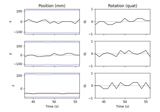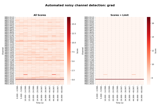mne.epochs.average_movements¶
-
mne.epochs.average_movements(epochs, head_pos=None, orig_sfreq=None, picks=None, origin='auto', weight_all=True, int_order=8, ext_order=3, destination=None, ignore_ref=False, return_mapping=False, mag_scale=100.0, verbose=None)[source]¶ Average data using Maxwell filtering, transforming using head positions.
- Parameters
- epochsinstance of
Epochs The epochs to operate on.
- head_pos
array|None If array, movement compensation will be performed. The array should be of shape (N, 10), holding the position parameters as returned by e.g.
read_head_pos.- orig_sfreq
float|None The original sample frequency of the data (that matches the event sample numbers in
epochs.events). Can beNoneif data have not been decimated or resampled.- picks
str|list|slice|None Channels to include. Slices and lists of integers will be interpreted as channel indices. In lists, channel type strings (e.g.,
['meg', 'eeg']) will pick channels of those types, channel name strings (e.g.,['MEG0111', 'MEG2623']will pick the given channels. Can also be the string values “all” to pick all channels, or “data” to pick data channels. None (default) will pick all data channels.- originarray_like, shape (3,) |
str Origin of internal and external multipolar moment space in meters. The default is
'auto', which means(0., 0., 0.)whencoord_frame='meg', and a head-digitization-based origin fit usingfit_sphere_to_headshape()whencoord_frame='head'. If automatic fitting fails (e.g., due to having too few digitization points), consider separately calling the fitting function with different options or specifying the origin manually.- weight_allbool
If True, all channels are weighted by the SSS basis weights. If False, only MEG channels are weighted, other channels receive uniform weight per epoch.
- int_order
int Order of internal component of spherical expansion.
- ext_order
int Order of external component of spherical expansion.
- regularize
str|None Basis regularization type, must be “in” or None. “in” is the same algorithm as the “-regularize in” option in MaxFilter™.
- destination
str| array_like, shape (3,) |None The destination location for the head. Can be
None, which will not change the head position, or a string path to a FIF file containing a MEG device<->head transformation, or a 3-element array giving the coordinates to translate to (with no rotations). For example,destination=(0, 0, 0.04)would translate the bases as--trans defaultwould in MaxFilter™ (i.e., to the default head location).- ignore_refbool
If True, do not include reference channels in compensation. This option should be True for KIT files, since Maxwell filtering with reference channels is not currently supported.
- return_mappingbool
If True, return the mapping matrix.
- mag_scale
float|str The magenetometer scale-factor used to bring the magnetometers to approximately the same order of magnitude as the gradiometers (default 100.), as they have different units (T vs T/m). Can be
'auto'to use the reciprocal of the physical distance between the gradiometer pickup loops (e.g., 0.0168 m yields 59.5 for VectorView).New in version 0.13.
- verbosebool,
str,int, orNone If not None, override default verbose level (see
mne.verbose()and Logging documentation for more). If used, it should be passed as a keyword-argument only.
- epochsinstance of
- Returns
- evokedinstance of
Evoked The averaged epochs.
- evokedinstance of
Notes
The Maxwell filtering version of this algorithm is described in [1], in section V.B “Virtual signals and movement correction”, equations 40-44. For additional validation, see [2].
Regularization has not been added because in testing it appears to decrease dipole localization accuracy relative to using all components. Fine calibration and cross-talk cancellation, however, could be added to this algorithm based on user demand.
New in version 0.11.
References
- 1
Taulu S. and Kajola M. “Presentation of electromagnetic multichannel data: The signal space separation method,” Journal of Applied Physics, vol. 97, pp. 124905 1-10, 2005.
- 2
Wehner DT, Hämäläinen MS, Mody M, Ahlfors SP. “Head movements of children in MEG: Quantification, effects on source estimation, and compensation. NeuroImage 40:541–550, 2008.

